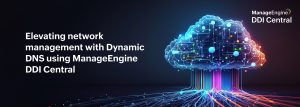In a DNS, a zone refers to a specific segment of the domain namespace, such as clouddns.manageengine.com or manageengine.com, where each segment can be a unique zone, including top-level domains, like .com. DNS servers translate domain names into IP addresses, assigning a specific IP to each zone as an authoritative response, representing network participants like services or hosts.
But networks today are ever-growing and so dynamic—with hosts regularly joining and exiting a network—that the ability to create new zones dynamically is essential, especially in environments where zones need to be added or removed without manual intervention.

In the realm of network administration, the seamless integration of DNS, DHCP, and IPAM (referred to as DDI) is pivotal for ensuring efficient network operations. ManageEngine DDI Central fills this essential role, offering a comprehensive suite for managing these critical components. A standout feature within this suite is Dynamic Domain Name System (DDNS), an approach that significantly enhances how networks handle IP address changes.
Let’s delve into what DDNS is. What role does it play in the context of DDI? We’ll explore why it matters more than ever in today’s dynamic network environments.
What is DDNS?
DDNS is a special extension of the DNS service that continuously monitors and updates DNS records with changing IP addresses, ensuring that the domain and host names consistently point to the correct IP addresses.

Consider a corporate network where each user or service has a fixed IP address. With the advent of 5G and the bring your own device (BYOD) trend, the number of devices employees use for work has increased significantly. Coupled with the explosion of the Internet of Things (IoT), there’s immense pressure on the availability of IP addresses, leading to a potential scarcity.of IP addresses.
This is where Dynamic Host Configuration Protocol (DHCP) in collaboration with DDNS steps in and dynamically leases out IP addresses to users for a specified period, say 24 hours, when they log in to a network. If they log out and don’t rejoin the network within 24 hours, the DHCP server recycles the IP address, reallocating it to another user in need. This dynamic address allocation strategy is essential to manage modern networks today, as it ensures efficient IP management amidst growing connectivity demands.
In the context of DDI, DDNS acts as a crucial bridge, dynamically linking DNS and DHCP services to achieve seamless IP address management without any manual intervention.
How to set up DDNS in ManageEngine DDI Central
Why DDNS matters
Automated IP address updates
Eliminate manual updates to DNS records that follow the changes in IP addresses—a time-consuming and error-prone process in traditional DNS setups. DDNS automates this process, directly interfacing with DHCP to update DNS records in real time as IP addresses are assigned or changed. This automation is particularly vital in environments where IP addresses frequently change, such as mobile networks, enterprise networks, virtual environments, and cloud services.
Enhanced network reliability
Boost network service reliability by ensuring DNS records remain up to date, enabling uninterrupted access to hostnames of users and applications, even as the underlying IP configurations keep changing over time.
Simplified network management
Automate and simplify network management tasks and relieve your network administrators from the burden of manual configurations of IP addresses and DNS entries, empowering them to focus on other critical aspects of the network infrastructure.
Improved security posture
Bolster network security with timely updates of DNS records via DDNS, as accurate DNS records are essential for various security mechanisms, including email validation and network policies that rely on domain names. By automating updates, DDNS reduces the risk of misconfigurations that could be exploited by malicious actors.
Empowering networks with DDNS using ManageEngine DDI Central
ManageEngine DDI Central integrates DDNS within its comprehensive DDI management features, offering a unified platform for handling the dynamic aspects of modern networks. Here is how it can empower your organization:
Streamlined configuration
Effortlessly set up and manage DDNS configurations, with ManageEngine DDI Central’s intuitive user interface and automation tools that make it easy to configure dynamic updates across both IPv4 and IPv6 networks.
Scalability for growth
Scale your network for growth with DDNS’s dynamic adaptability, efficiently managing vast numbers of automated DNS records and IP changes, ensuring that growth does not compromise connectivity or service quality.
Visibility and control
Help your administrators gain full visibility into the status of DNS records and IP address lease assignments, enhanced by real-time updates through DDNS. This visibility is crucial for diagnosing issues and optimizing network performance.
Security and compliance
Secure DDNS updates through transaction signature (TSIG)-based transactions, enhancing authentication and authorization. This security measure not only strengthens the update protocol but also ensures compliance with various regulatory standards, providing a secure and regulatory-aligned DDNS service.
Within the context of a DDI solution, DDNS is a transformative method that adapts DNS to the dynamic nature of today’s network environments. Try ManageEngine DDI Central now to leverage DDNS to achieve a new level of efficiency, reliability, and security in you network operations.
Whether managing a small enterprise network or a large-scale service provider infrastructure, ManageEngine DDI Central’s DDNS feature ensures that connectivity and accessibility are always maintained, paving the way for a more resilient and agile network ecosystem.

